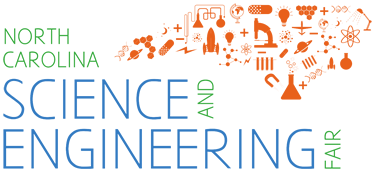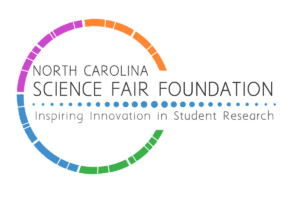How It Works
Who are the judges?
Judges are educators and other professionals across the sciences and engineering disciplines. Each has earned at least a bachelor’s degree in a scientific, technical, or educational field. Exceptions may be made for equivalent military, vocational or other related experience, please contact judges@ncsciencefair.org for details.
While many judges are from North Carolina’s Research Triangle area, all are welcome. Judges from outside the state and even overseas have volunteered in past years, especially during virtual judging via Zoom.
Time Commitment:
- 2-5 hours week prior to review projects
- In-person judging (March 21, 2026) : 8 am to approximately 3 pm (the time you’ll finish depends on the division you are judging and the number of projects assigned to your category)
- Virtual judging (March 17, 2026): 8:30 am to 1pm judging projects via Zoom
For questions about being a judge please contact the Judge Coordinator at judges@ncsciencefair.org
What happens on fair day
You’ll work in a small team of other judges in one of the eight categories (scroll through this Rules link to the catgories) or in evaluating projects for special awards provided by professional organizations, the military, NASA and NOAA, etc. Be sure to Indicate what you are interested in judging when you sign up.
Orientation training will be provided before the fair describing the process in greater detail.
About a week before the fair, each judge will receive their category or special award assignment, the scoring rubric, and access to the projects materials to familiarize themselves with and begin brainstorming some questions to ask each student. Most judges spend about 2-3 hours on this step.
Each judge will receive a list of special awards and information on how they will be awarded.
Virtual Judging
Some students will present their projects virtually, via Zoom, a few days before the fair. Judges will login to their assigned Zoom Session and interview students in teams of judges. You’ll ask the same questions, and provide the same encouragement as you would judging in person. Following the student interviews judges will caucus together to deliver scores for each project so that it may be considered with projects presented in-person.
Virtual judges who are also available to judge in-person provide a perspective that helps ensure a level playing field for students regardless of how they choose to participate. Judges who are available only for virtual judging should also provide comments to their lead judge on projects they feel strongly should be considered for categorical or special awards on Saturday.
In-Person Judging
On the day of the fair, judges arrive as the students are checking in, usually around 8 a.m. Coffee and a light breakfast is provided as they meet up with the other judges on their team and receive instructions before beginning the process of reviewing projects and interviewing students.
Each judge record scores based on the rubric provided and then caucuses with fellow judges in their category to compare notes and select the winners. A head judge from each category lead the caucus to include results from virtual and in-person judging. They would then send the results to the Fair Director. and Awards Chair. The Judges Room will be open all day with refreshments available.
The “What to Expect” link on the left as more detailed for first time (and long time) judges.
Along with your role as an evaluator of student projects, your encouragement and motivation of each student to continue pursing science is just as important. Judges should do what they can to help each student walk away from the fair with a sense of pride and accomplishment.
How to Judge
Judges Handbook
Download the judges handbook of more detailed information on judging science fair projects including the rubric and explanations of each criteria.
The judging criteria is also available for download. Students are encouraged to look these over before the fair as well.
General Tips
Finalists may have worked on a research project for more than one year. However, for the purpose of judging, ONLY research conducted since the last Intel ISEF is to be evaluated. Although previous work is important, it is not to be considered as part of this year’s ISEF project.
Examine the quality of the finalist’s work, and how well the finalist understands his or her project and area of study. The physical display is secondary to the student’s knowledge of the subject. As mentioned earlier, if the project is a multi-year effort, the Finalist is required to have an Intel ISEF Continuation Projects Form 7 visible at the project. Please be cognizant of the fact that the only work being judged should be that completed in the year prior to this.
When research is conducted in an industrial or institutional setting, the finalist is required to include Intel ISEF Form 1C with the project documentation. Judges should review in detail the supervising scientist’s comments on Intel ISEF Form 1C when evaluating research conducted in an industrial or institutional setting. Be aware that the SRC approved gold seal embossed abstract is a tremendous source of information regarding the finalist’s project and research.
Look for evidence of laboratory, field or theoretical work, not just library research or gadgeteering.
Compare projects only with those competing at the Intel ISEF and not with projects seen in other competitions or scholastic events.
When submitting the score for each finalist’s project, you must enter only the cumulative score on the scan card for that finalist. As discussed in the previous chapter, the maximum score a finalist can obtain is 100.
Judges should keep in mind that the Science Fair is not only a competition, but also an educational and motivating experience for the finalists. The high point of the fair for the majority of finalists is their judging interviews.
As a general rule, judges represent professional authority to finalists. For this reason, judges should use an encouraging tone when asking questions, offering suggestions or giving constructive criticism. Judges should not criticize, treat lightly, or display boredom toward projects they personally consider unimportant. Always give credit to the finalist for completing a challenging task and/or for their success in previous competitions. Please be discreet when discussing winners or making critical comments in elevators, restaurants, or elsewhere, as finalists or adult escorts might overhear. Results are confidential until announced at the awards sessions. The Host Committee judging volunteers and the individual judges for both Grand Awards and Special Awards are responsible for ensuring that all items associated with judging, with the exception of the official results certification, are collected and destroyed at the conclusion of judging.
What to Expect
You’ll be judging alongside some of North Carolina’s top educators and professionals in their fields, but you don’t need a Ph.D. to volunteer as a judge both at the state and regional levels. Students benefit from interacting with judges from a broad set of backgrounds.
How it works
Judging generally requires about half a day, on a Friday afternoon or Saturday morning. Judges arrive, have a brief meeting to go over the procedures, form judging teams, and ensure each of the special awards will be judged. Schedule details including where to park, where to meet, etc. will be provided via email in the days leading up to the fair.
When signing up to judge, select divisions (elementary, junior (middle school) or senior (high school) and indicate your level of expertise (from none to expert) in the available category (scroll through this Rules link to the 8 catgories).
You’ll be assigned to a category. or special award(s), meet other judges considering that category. Lead judges will be selected for each division/category who are responsible for completing score sheets for presentation to the awards committee which prepares awards, including personalizing certificates where necessary.
Fan out to evaluate projects without students present. There you’ll get a chance to review posters, reports, notebooks or other items students include with their projects. Students will then join their projects. Throughout the process, projects are referenced by the project number (which indicates the division and category and a number) assigned as students register.
Each project and the student(s( presenting it will be visited by multiple judges, both judging within the category and possibly by judges considering special awards.
Judges then come together, often by division and category, to select projects to receive category and special awards as well as those that will compete at the next level. Awards are presented to students at the end of the fair before students leave. Judges are free to leave at that point or are welcome to attend the awards ceremony, and it’s worth doing especially if it is your first time judging.
What to bring
Be prepared to take notes, you’ll be seeing a lot of projects and talking with a lot of students. Your notes will be useful as you discuss projects with other judges. You’ll find the day goes very quickly so make the most of it.
- something to take notes with (notepad, tablet, etc. whatever works best for you)
- something to write with (pen, etc.)
- a clipboard, portfolio, or some other way to keep track of score sheets and notes.
How we judge
The students you meet probably already have won or placed in their school science fairs. They will be proud of their accomplishments and should be able to explain their projects clearly and concisely. This explanation should include what they did as well as their results and conclusions. Their displays should clearly show the intent and outcomes of experimentation, and they should be able to answer questions about their projects at levels appropriate to their ages and grade levels. They should be able to describe the methodology and equipment employed and the thought processes that were used to develop their hypotheses, experimental designs, results, and conclusions.
You should not be surprised to find projects vary widely in quality and sophistication. Some projects, particularly at the high school level, may be comparable to what you would expect in graduate school or professional presentations. Some displays will be elaborate while most others will be more simple. All will be considered for awards on the basis of their content.
The purpose of the display is to clearly communicate the project’s purpose, hypothesis, methodology, results, conclusions, and other information relevant to the investigation. A simple, clear, and well-organized display is to be preferred over one that is ornate but falls short of accomplishing this purpose. The efficacy of the display and communication of the content is of primary importance, not the investment in the materials.
Why we judge
While judges are ultimately selecting a list of projects and students that will go home with awards, the primary purpose of the North Carolina Science and Engineering Fair is to boost student research at all levels. Their project was selected to compete at the top level in the state, celebrate that with them! Every student should also be encouraged to continue their research.
Leave each student knowing that you are interested in their project and what they had to say.
All this is challenging because of the short amount of time each judge has with each student, but our goal is to help ensure each student participating goes home proud of their accomplishment and thinking about their next science fair project.

